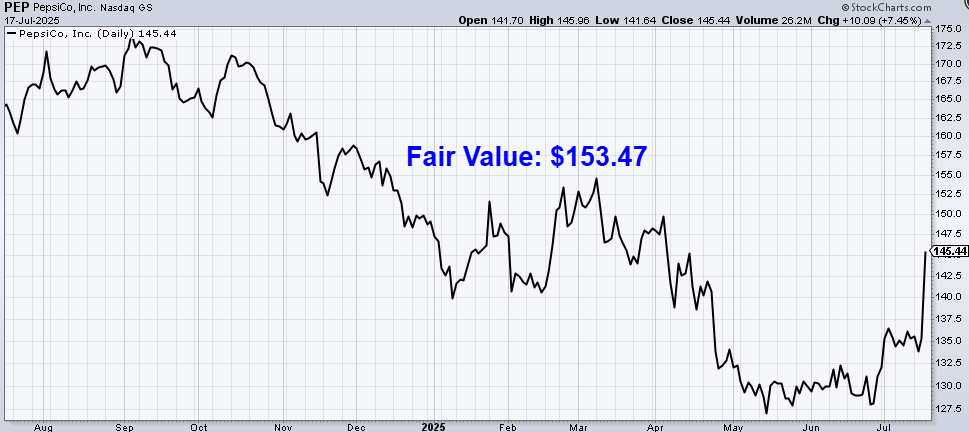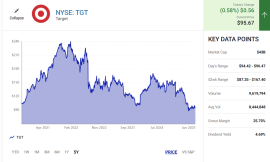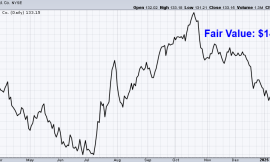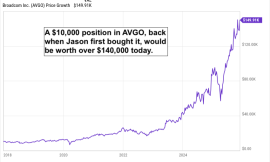Investing used to be something reserved for a privileged few.
If we go back even just 20 years ago, brokerages were difficult and expensive to access, and research was very hard to come by.
Going back even further – say, 50 or so years ago – puts you in a world in which almost no regular people could invest regularly or effectively.
But investing has been democratized, with commission fees almost completely gone and the world’s data available at the touch of a button.
Regular people like you and I can invest with ease.
This unlocks the ability for us mere mortals to reach financial freedom, which is something the serfs and laborers of yesteryear could only dream of.
And the best way to achieve financial freedom might be through the dividend growth investing strategy, which is a long-term investment strategy that leads to buying and holding shares in high-quality businesses rewarding shareholders with steadily rising cash dividend payments.
Those rising cash dividend payments, of course, must be funded by rising profits (i.e., you can’t pay out cash you don’t have).
And rising profits only come about when businesses are being run well and doing things right.
It’s a “trust but verify” type of model: Quality deserves trust, but rising cash dividend payments are verification.
You can see what I mean by pulling up the Dividend Champions, Contenders, and Challengers list, which has put together invaluable information on hundreds of US-listed stocks that have raised dividends each year for at least the last five consecutive years.
These are some of the best businesses in the world, showing how quality breeds results.
One of those results circles back to my earlier point, where regular investment in some of these businesses can eventually build enough dividend income to live off of (thus, unlocking that financial freedom I mentioned).
I know how this works firsthand, reaching financial freedom and even being able to retire in my early 30s.
That’s when my FIRE Fund, which is my real-money portfolio, started to generate enough five-figure passive dividend income for me to live off of.
For more on how such an early retirement is possible, make sure to read my Early Retirement Blueprint.
Now, one other critical part of the dividend growth investing strategy is valuation.
Price only represents what you pay, but value represents what you get.
An undervalued dividend growth stock should provide a higher yield, greater long-term total return potential, and reduced risk.
This is relative to what the same stock might otherwise provide if it were fairly valued or overvalued.
Price and yield are inversely correlated. All else equal, a lower price will result in a higher yield.
That higher yield correlates to greater long-term total return potential.
This is because total return is simply the total income earned from an investment – capital gain plus investment income – over a period of time.
Prospective investment income is boosted by the higher yield.
But capital gain is also given a possible boost via the “upside” between a lower price paid and higher estimated intrinsic value.
And that’s on top of whatever capital gain would ordinarily come about as a quality company naturally becomes worth more over time.
These dynamics should reduce risk.
Undervaluation introduces a margin of safety.
This is a “buffer” that protects the investor against unforeseen issues that could detrimentally lessen a company’s fair value.
It’s protection against the possible downside.
Amassing a large portfolio through careful selection of undervalued high-quality dividend growth stocks can allow for regular people to build enough passive dividend income to become financially free, which is something our ancestors could only dream of.
Of course, taking great care around valuation first requires one to understand the whole concept of valuation.
If you don’t already have a firm understanding in place, Lesson 11: Valuation can help a great deal.
Written by fellow contributor Dave Van Knapp, it lays out valuation using simple terminology and even provides an easy-to-use valuation template you can use on your own to quickly value just about any dividend growth stock you’ll run across.
With all of this in mind, let’s take a look at a high-quality dividend growth stock that appears to be undervalued right now…
PepsiCo Inc. (PEP)
PepsiCo Inc. (PEP) is an American multinational food, snack, and beverage corporation.
Founded in 1898, PepsiCo is now a $184 billion (by market cap) snack and beverage beast that employs more than 300,000 people.
The company reports results across seven segments: PepsiCo Beverages North America, 30% of FY 2024 revenue; Frito-Lay North America, 27%; Europe, 15%; Latin America, 13%; Africa, Middle East, and South Asia, 7%; APAC (Asia Pacific), 5%; and Quaker Foods North America, 3%.
The company generates approximately 56% of revenue from the US; the remainder is generated internationally.
PepsiCo runs a simple but extremely effective business model, selling beloved beverages and snack foods to billions of people across the world.
It’s not sexy.
But it works.
This simple business model has allowed PepsiCo to thrive for ~125 years and turn into an enterprise worth nearly $200 billion.
It’s also helped PepsiCo to build more than 20 different billion-dollar brands (i.e., brands that do more than $1 billion per year in sales), which includes Aquafina, Doritos, Lay’s, Mountain Dew, and the eponymous Pepsi.
Put simply, PepsiCo has a consumer products empire.
These brands have a loyal customer base who prefer the consistent and familiar taste profiles of these products, and that greatly helps to cement PepsiCo’s pricing power among its products.
While it might not be growing as fast as some of the high-tech firms out there, PepsiCo’s enduring nature, visible and recurring revenue (because beverages and snacks must be purchased again once consumed, and repeat purchases are easy to make since these products have a high enjoyment factor against low price points), and overall resilience provides a lot of comfort.
You know what else provides a lot of comfort?
PepsiCo’s legendary track record of rewarding shareholders with rising dividends, which have been funded by decades of rising revenue and profit.
Dividend Growth, Growth Rate, Payout Ratio and Yield
Indeed, PepsiCo has raised its dividend for 53 consecutive years.
Just think about doing anything consistently for 50+ years.
Then imagine doing ever-more of it over that stretch.
It’s pretty incredible, and it speaks on the resilience of the business model and its roster of brands.
Its 10-year dividend growth rate is 7.9%, which is solid (albeit not amazing), although more recent dividend increases have been in a mid-single-digit range.
Still, this is enough to move the needle against inflation and keep one’s purchasing power intact.
It’s also more than enough to make sense of the stock, considering this dividend growth is being layered on top of the stock’s starting yield of 4.2%.
This rich yield is in the territory of utilities and REITs, which is a shocking situation to be in for a stock that has historically been viewed as a blue-chip consumer name.
To put that in perspective, this yield is 140 basis points higher than its own five-year average.
To get a 4%+ starting yield out of this stock is almost unheard of, and I think this is an early indication of what kind of rare and unusual investment opportunity we may be looking at here.
With a payout ratio of 70.9%, based on TTM Core EPS, PepsiCo’s dividend is covered, but I’d also like to see a healthier payout ratio.
Unless there’s a growth acceleration in the business, dividend growth over the near term will be constrained and likely to maintain its recent MSD type of growth trajectory.
Again, keep in mind, that’s coming on top of a 4%+ yield.
It’s a very nice combination of yield and growth.
It’s a better setup than you’re going to find across a lot of competing stocks (such as most REITs) offering this kind of yield.
And it’s a better setup than PepsiCo’s stock has almost always had.
Revenue and Earnings Growth
As much as that may be the case, though, these dividend metrics are mostly looking into the rearview mirror.
However, investors must always be looking through the windshield, as the capital of today is risked for the rewards of tomorrow.
Thus, I’ll now build out a forward-looking growth trajectory for the business, which will be useful during the valuation process.
I’ll first show you what the business has done over the last decade in terms of its top-line and bottom-line growth.
And I’ll then reveal a professional prognostication for near-term profit growth.
Lining up the proven past with a future forecast in this manner should give us some idea of where the business could be going from here.
PepsiCo grew its revenue from $63.1 billion in FY 2015 to $91.9 billion in FY 2024.
That’s a compound annual growth rate of 4.3%.
Not bad.
For a company going on more than 125 years old and starting off with a large base, compounding the top line at a 4%+ clip annually is actually quite admirable.
Meanwhile, earnings per share increased from $3.67 to $6.95 over this period, which is a CAGR of 7.4%.
This is close to the dividend growth rate, showing us deft capital allocation and prudent awareness out of management.
Steady buybacks helped lead to excess bottom-line growth, with the outstanding share count down by more than 7% over the last 10 years.
Looking forward, CFRA believes that PepsiCo will compound its EPS at an annual rate of 5% over the next three years.
I view this as a reasonable expectation out of a high-quality but mature food and beverage company.
CFRA does a good job of summing it up with this passage: “…[PepsiCo] is a higher-quality, low-beta, blue-chip company with a strong balance sheet and high degree of earnings stability. We also like the power of its various brands, such as Frito-Lay, Gatorade, Pepsi, and Mountain Dew, as we believe they give the company the ability to successfully pass through higher costs to consumers in the form of price increases. Longer term, we see faster-growing international markets and the Frito-Lay business as the primary growth drivers. [PepsiCo]’s focus on healthier snacks and beverages will also continue to drive the top line, in our view.”
PepsiCo has plenty of stability and resiliency, fortified by its large stable of global, billion-dollar brands.
However, it’s also a mature, global business that simply cannot grow terribly fast.
It’s up to an individual investor to decide what matters to them and where (or whether) something like PepsiCo fits in a portfolio.
In addition to the above passage, CFRA also highlights PepsiCo’s reduced cost pressures and higher volumes over the near term.
The focus on healthier options is also a bright spot in the changing consumer landscape (which has shifted demand toward products which are perceived to be more wholesome), which has resulted in PepsiCo launching or acquiring various products across brands such a Bubly, Poppi, and Sabra.
If we take that 5% EPS growth expectation as a baseline figure to go off of, that puts PepsiCo’s dividend in a position to grow at a similar rate.
And I think that’s a fair amount of growth to receive on a stock already yielding over 4%.
It won’t “wow” anyone.
Instead, it’s just a steady long-term investment that can incrementally move one’s wealth and dividend income forward over time.
Financial Position
Moving over to the balance sheet, PepsiCo has a good (but not great) financial position.
The long-term debt/equity ratio is 2, while the interest coverage ratio is 13.
The former number looks worse than it really is, as PepsiCo has a low common equity figure.
However, the long-term debt load of ~37 billion is not overly concerning for a company of this size and magnitude.
The company has credit ratings which are well into investment-grade territory: A1, Moody’s; A+, S&P.
Profitability for the firm is outstanding.
Return on equity has averaged 51.8% over the last five years, while net margin has averaged 10.1%.
ROE is juiced by the structure of the balance sheet, but even ROIC is often in a high-teens range.
PepsiCo isn’t growing as fast as it used to, but it undoubtedly remains one of the world’s premier branded food and beverage companies.
And with economies of scale, a global distribution network, IP, R&D, brand power, and barriers to entry through established retail relationships with dedicated shelf space, the company does benefit from durable competitive advantages.
Of course, there are risks to consider.
Regulation, litigation, and competition are omnipresent risks in every industry.
Regulation, especially with the stance of the current HHS, could be an even larger hurdle for PepsiCo and its slate of processed snacks.
Adding to the regulatory pressure, there are general and changing consumer trends toward healthier foods, which may negatively impact sales across some of PepsiCo’s products that lean more into taste/enjoyment than outright health.
Technology and the rise of alternative forms of media make it easier for new entrants to come into the market, advertise, make themselves known to consumers, and compete with entrenched giants like PepsiCo.
PepsiCo must continue to navigate different tastes in different markets, as well as evolving consumer tastes and preferences globally.
The company’s international footprint exposes it to exchange rates and geopolitical risks (such as tariffs).
Input costs can be volatile.
Passing on higher costs by raising prices on products can lead to lower volumes and strained relationships with retailers.
The balance sheet isn’t as strong and flexible as it used to be, which puts a lid on what management can do with capital allocation (M&A, buybacks, etc.).
Because of the law of large numbers, PepsiCo’s absolute size may be a hindrance to relative growth.
There are certainly some risks to be aware of, but I think PepsiCo’s blue-chip stature offsets a lot of the risks.
What also offsets a lot of the risks is the valuation, which is near an all-time low…
Valuation
The stock is sitting at a P/E ratio of 16.7, based on TTM Core EPS.
That is almost absurdly low for this business.
Even if we go by GAAP EPS, the P/E ratio of 19.9 is way below its own five-year average of 26.3.
The cash flow multiple, which moves past GAAP fluctuations, is at just 13.7, which is well off of its own five-year average of 18.3.
And the yield, as noted earlier, is significantly higher than its own recent historical average.
So the stock looks cheap when looking at basic valuation metrics. But how cheap might it be? What would a rational estimate of intrinsic value look like?
I valued shares using a dividend discount model analysis.
I factored in a 10% discount rate and a long-term dividend growth rate of 5.5%.
This growth rate is roughly in line with the near-term expectation for PepsiCo’s EPS growth, and it also lines up nicely with recent dividend raises.
Admittedly, a 5.5% growth rate is lower than what I’ve used in the past for PepsiCo, as I think the company’s size, ongoing shifts in the market, and recent price taking (which has negatively impacted volumes) have all taken their toll on the company’s growth profile.
Still, this would not be all that disappointing.
After all, this is a blue-chip company which is appealing not for its growth abilities but rather for its stability and resilience (particularly as it relates to the dividend).
And that resilience is not being called into question at all.
It won’t shoot the lights out, but PepsiCo still appears capable of growing the business and dividend at a decent, inflation-beating clip.
In my opinion, that’s enough.
The DDM analysis gives me a fair value of $133.40.
The reason I use a dividend discount model analysis is because a business is ultimately equal to the sum of all the future cash flow it can provide.
The DDM analysis is a tailored version of the discounted cash flow model analysis, as it simply substitutes dividends and dividend growth for cash flow and growth.
It then discounts those future dividends back to the present day, to account for the time value of money since a dollar tomorrow is not worth the same amount as a dollar today.
I find it to be a fairly accurate way to value dividend growth stocks.
The stock looks roughly fairly valued from my vantage point.
But we’ll now compare that valuation with where two professional stock analysis firms have come out at.
This adds balance, depth, and perspective to our conclusion.
Morningstar, a leading and well-respected stock analysis firm, rates stocks on a 5-star system.
1 star would mean a stock is substantially overvalued; 5 stars would mean a stock is substantially undervalued. 3 stars would indicate roughly fair value.
Morningstar rates PEP as a 4-star stock, with a fair value estimate of $162.00.
CFRA is another professional analysis firm, and I like to compare my valuation opinion to theirs to see if I’m out of line.
They similarly rate stocks on a 1-5 star scale, with 1 star meaning a stock is a strong sell and 5 stars meaning a stock is a strong buy. 3 stars is a hold.
CFRA rates PEP as a 4-star “BUY”, with a 12-month target price of $165.00.
I came out low, surprisingly. Averaging the three numbers out gives us a final valuation of $153.47, which would indicate the stock is possibly 13% undervalued.
Bottom line: PepsiCo Inc. (PEP) is one of the most successful food and beverage companies in the world, commanding a huge lead over would-be competitors with 20+ billion-dollar brands. Its brands have unrivaled mindshare and pricing power. Although it’s not growing as quickly as it once was, it remains a blue-chip firm with incredible resilience. With a market-smashing yield, inflation-beating dividend growth, a manageable payout ratio, more than 50 consecutive years of dividend increases, and the potential that shares are 13% undervalued, this is about as close to an obvious long-term investment as it gets for dividend growth investors.
-Jason Fieber
Note from D&I: How safe is PEP’s dividend? We ran the stock through Simply Safe Dividends, and as we go to press, its Dividend Safety Score is 93. Dividend Safety Scores range from 0 to 100. A score of 50 is average, 75 or higher is excellent, and 25 or lower is weak. With this in mind, PEP’s dividend appears Very Safe with a very unlikely risk of being cut. Learn more about Dividend Safety Scores here.
P.S. If you’d like access to my entire six-figure dividend growth stock portfolio, as well as stock trades I make with my own money, I’ve made all of that available exclusively through Patreon.
Disclosure: I’m long PEP.




